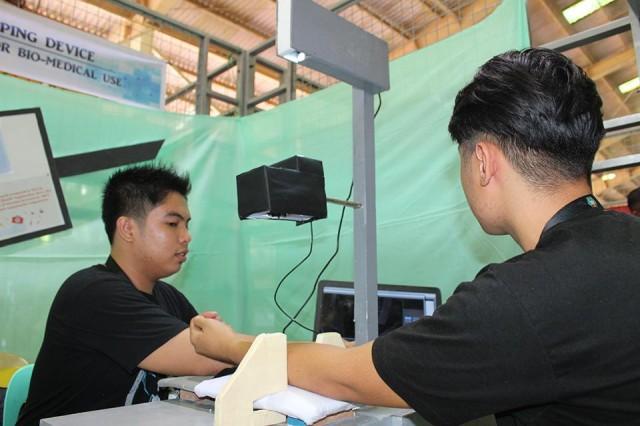Pinoy college students invent a low-cost device that accurately locates people's veins
A team of Pinoy college students from the Don Honorio Ventura State University invented an affordable electronic vein mapping device that aims to help medical practitioners find the exact locations of patients' veins.
This invention, which placed as a runner up in the Student Creative Research Category of the recently-concluded 2019 DOST - Central Luzon's Regional Invention Contest and Exhibit (DOST-RICE), aimed to greatly reduce the number of unsuccessful vein puncture procedures.
Their invention was described as an "interesting find at the DOST RICE competition" on the Facebook page of Department of Science and Technology (DOST) Secretary Fortunato dela Pena.

Photo courtesy of the Department of Science and Technology
Nichole Dalay, one of the team members, said that this is the first locally-made and affordable vein mapping device in the Philippines. The device was tested on hundreds of DOST RICE participants, and it was able to "illuminate" people's veins in real-time.
According to the team's paper, the device uses infrared light (IR) to locate the vein, a CMOS camera to scan the image, a MATLAB-coded "Vein Mapper App" to process and enhance the image, and a mini projector to project the image back onto the skin by visible light.
The device is connected to a laptop through a USB port.
The team explained that infrared (IR) light was the best way to illuminate the patients' veins because IR deoxidized hemoglobin, a component in blood, which made the veins look darker in the captured photos.
Affordability
The group said that their vein mapping device costs about P5,000, whereas medical devices available in the market today costs around P200,000.
"Commercial medical devices cost P200,000 when converted. So 'yung amin po, low cost siya. Pwede siya maifund ng government for local hospitals. Sobrang baba ng presyo niya compared sa mga international, commercial na vein mapping," Dalay said, in an exclusive interview with GMA News Online.
Dalay added that only high-end hospitals could afford the costs of commercial vein mapping devices made in other countries. With the advent of a more affordable, locally-assembled alternative, public hospitals can greatly benefit from the invention.
Substitute for manual procedures
The device is also seen as a substitute for traditional methods in locating patients' veins.
Some of these traditional methods include: pressing two fingers over the middle of the venous segment to locate the underlying vein, slapping the skin, warming the area, and using a tourniquet.
"Although professionals na 'yung gumagawa, hindi po nila maiwasan magkakamali through the manual procedures because wala pong definite na procedure kung papaano mag-pop ng veins. Mga traditional techniques lang po 'yung ginagamit," said Shayne Tungol, one of the team members.
In their study, the team quoted a 2016 World Health Organization (WHO) report saying that unsuccessful venipuncture operations can increase the risk of infection by 100 percent.
Another team member, Allain Christian Villaluz, said he experienced being injected in the wrong spot several times during a check-up at a local clinic.
"Dati po, nung nagpa-check up ako [sa clinic]. Minsan po tutusok sila tapos magkakamali po, uulitin nanaman. Masakit din. Minsan namamaga, nagpapasa po," he shared.
Limitations
Although the team's new device can help lower unsuccessful venipuncture rates in patients, it has some limitations.
"This project is only effective in a given range of operations, and in other cases such as burnt skin, micro-pigmentation, it does not give the output this research is aiming," the team said in their paper.
They added that the device was still a prototype, and it had to be patented at the Intellectual Property Office of the Philippines (IPO).
Asked about the future of the invention, Dalay said that the team is planning to upgrade their device by using different materials, sophisticated coding, and improving on its portability.
After placing as runner up at the prestigious DOST invention competition, the team won P 10,000 in cash and DOST's support for an IPO patent.
"I hope everyone will know the importance of research po, especially the government. I hope the government supports the funding for researches. Especially para sa public benefit naman siya," Tungol said.
The students who worked on the invention are: Mary Nichole G. Dalay, Cristene Kiarra C. Flores, Jake Lester D. Gonzales, Anthony A. Tio, Shayne G. Tungol and Allain Christian M. Villaluz. Their adviser was Engr. Karl Angel M. Gamboa.
—JCB, GMA News





